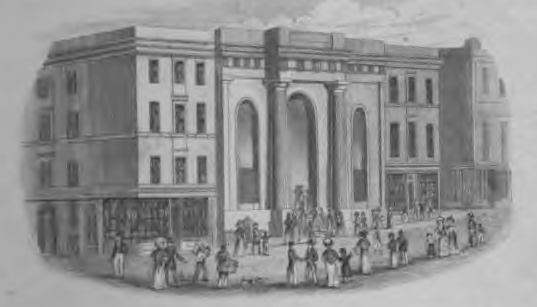Charles Edge (architect) on:
[Wikipedia]
[Google]
[Amazon]


 Charles Edge (13 October 1800 – 21 July 1867) was a British architect based in
Charles Edge (13 October 1800 – 21 July 1867) was a British architect based in

Birmingham
Birmingham ( ) is a City status in the United Kingdom, city and metropolitan borough in the metropolitan county of West Midlands (county), West Midlands in England. It is the second-largest city in the United Kingdom with a population of 1. ...
.
Career
Edge was born on 13 October 1800. He studied architecture in London for 5 years, and set himself up in practice in Bennetts Hill, Birmingham in 1826. He became one of the leading architects in Birmingham. After the failure of the contractors building Birmingham Town Hall, Edge was employed to complete the building. For many years he worked in partnership with Avery. His son, Charles Allerton Edge became an architect working with his father. Edge also employedYeoville Thomason
Henry Richard Yeoville Yardley Thomason (17 July 1826 – 19 July 1901) was a British architect active in Birmingham. He was born in Edinburgh to a Birmingham family, and set up his own practice in Birmingham 1853–54.
Life
Yeoville ...
.
He died on 21 July 1867 at Edgbaston
Edgbaston () is an affluent suburban area of central Birmingham, England, historically in Warwickshire, and curved around the southwest of the city centre.
In the 19th century, the area was under the control of the Gough-Calthorpe family a ...
.
Works
*5 Bennetts Hill, Birmingham, 1827 *6 Bennetts Hill, Birmingham, 1827 *Wesleyan Methodist Church, Constitution Hill, Birmingham, 1827–28 *112Colmore Row
Colmore Row is a street in Birmingham City Centre in the centre of Birmingham, England, running from Victoria Square to just beyond Snow Hill station. It is traditionally the city's most prestigious business address.
Colmore Row and its envir ...
, Birmingham, c.1829 (probable)
*The Public Office, Moor Street, Birmingham, 1829–30
*Birmingham Market Hall
Birmingham Market Hall was a municipal market hall in the Bull Ring area of Birmingham, England (and part of the city centre there), from 1835 to 1940, when the interior and roof were destroyed by enemy bombing; although parts remained in use ...
, High Street, Birmingham, 1832–35 (destroyed in the Birmingham Blitz
The Birmingham Blitz was the heavy bombing by the Nazi German '' Luftwaffe'' of the city of Birmingham and surrounding towns in central England, beginning on 9 August 1940 as a fraction of the greater Blitz , which was part of the Battle of Br ...
, 1940; remains demolished 1963)
*Bank of Birmingham, Bennetts Hill, Birmingham 1833 (afterwards Branch Bank of England)
*Scottish Presbyterian Church, Broad Street, Birmingham, 1834 (rebuilt 1848–49 by J. R. Botham)
*St Peter's Church, Dale End, Birmingham, 1834–37 (rebuilding after fire damage. Demolished 1899)
* Birmingham Town Hall, 1835 alterations
*Key Hill Cemetery
Key Hill Cemetery, ( OS grid reference SP059882), originally called Birmingham General Cemetery, is a cemetery in Hockley (the Jewellery Quarter), Birmingham, England. It opened in 1836 as a nondenominational cemetery (in practice nonconfor ...
, 1835–36
*The Crescent, Filey, Yorkshire, 1835–38
*Birmingham and Midland Bank, Union Street, Birmingham, 1836
*Aspley House, 39 Wellington Road, Birmingham, 1836
*Regent Works, Vittoria Street/Regent Street, Birmingham, 1837–38
* Birmingham Town Hall, 1837 extension
*15 Chad Road, Birmingham, 1838
*The Independent Chapel, King Street, Dudley
Dudley is a large market town and administrative centre in the county of West Midlands, England, southeast of Wolverhampton and northwest of Birmingham. Historically an exclave of Worcestershire, the town is the administrative centre of the ...
, 1839
*Victoria Works, Vittoria Street/Frederick Street, Birmingham 1839–40
*National Provincial Bank, Bennett Hill, Birmingham, 1840
*Block, Temple Street/New Street, Birmingham, 1842 (demolished c.1950)
*St Paul's School, Warstone Lane, Birmingham, 1844
*Norwich Union Fire Engine House, Temple Street, Birmingham, 1846 (with Avery)
*Coade stone fountain, Birmingham Botanical Gardens, 1850
*Savings Bank, 31 Cannon Hill, Birmingham, 1850
* Birmingham Town Hall, 1850 extension
*Aston Waterworks Engine House, Birmingham, 1851
*Lily House, Birmingham Botanical Gardens, 1852
* St George's Church, Edgbaston, 1855–57 chancel
*Birmingham Gun Barrel Proof House, 1860 alterations
*Powell's Gun Shop, 35–37 Carrs Lane, Birmingham, 1861
Personal life
Edge married Ellen Allerton (1810–1871), second daughter of Thomas Allarton of Lozells, Birmingham, on 30 October 1833 in Aston, Birmingham. Their children were: *Frances May Edge (1836–1920) *Ellen Edge (1843–1917) *Charles Allerton Edge (1844–1907) (also an architect and father of sculptor and anthropologist Marguerite Milward"Marriage of Mr P. H. Milward and Miss Rosa Edge". ''Leamington Spa Courier''. 22 February 1901.) *Sarah Margaret Edge (1847–1898) *John Quarrendon Edge (b.1848) *Hall Travers Edge (1850–1915)References
{{DEFAULTSORT:Edge, Charles 19th-century English architects Architects from Birmingham, West Midlands 1800 births 1867 deaths